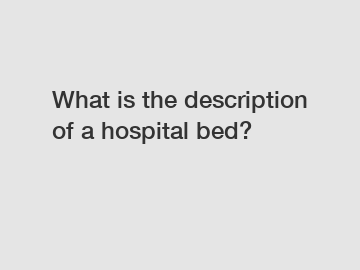What is the description of a hospital bed?
What is the Description of a Hospital Bed?
Hospital beds are specially designed beds that provide comfort and support for patients during their stay in medical facilities. These beds are an essential component of healthcare infrastructure, offering various features to meet the needs of patients and healthcare providers. In this article, we will explore the description of a hospital bed, highlighting its components, functionalities, and benefits.
Components of a Hospital Bed:

A hospital bed typically consists of several key components that work together to ensure the patient's comfort and safety. These components include:
1. Bed Frame:
The bed frame is the foundation of a hospital bed. It is usually made of sturdy steel or aluminum to provide stability and durability. The frame is designed in a way that allows easy adjustment and positioning of the bed.
2. Mattress:
The mattress of a hospital bed is specially designed to prevent pressure ulcers and provide optimal comfort. It is often made of high-density foam or alternating air cells to distribute pressure and reduce the risk of skin breakdown.
3. Side Rails:
Side rails are crucial for patient safety, especially for those at risk of falling or who may need assistance with repositioning. These rails can be raised or lowered, creating a barrier to prevent patients from rolling out of bed.
Functionalities of a Hospital Bed:
Hospital beds offer a range of functionalities to accommodate the diverse needs of patients. Some common functionalities include:
1. Adjustable Height:
Hospital beds can be easily adjusted in height, allowing healthcare providers to find the most comfortable and ergonomic position for patient care. This feature also simplifies tasks such as transferring patients to and from wheelchairs or other medical equipment.
2. Trendelenburg Position:
The trendelenburg position is when the bed is tilted with the head lower than the feet. This position is commonly used during surgeries or to improve blood flow and circulation in critically ill patients.
3. Electric Controls:
Most modern hospital beds are equipped with electric controls that allow patients to adjust the bed's position with minimal effort. These controls enable patients to find the most comfortable position without depending on assistance from caregivers.
Benefits of a Hospital Bed:
Hospital beds offer numerous benefits to both patients and healthcare providers. Some key advantages include:
1. Enhanced Comfort:
The adjustable features and pressure-relieving mattresses of hospital beds contribute to enhanced patient comfort, promoting healing and relaxation during their stay at the medical facility.
2. Improved Caregiver Efficiency:
The functionalities of hospital beds, such as adjustable height and electric controls, enable healthcare providers to deliver care more efficiently. These features reduce the strain on caregivers during tasks like lifting, transferring, and repositioning patients.
3. Patient Safety:
The inclusion of side rails and various adjustable positions ensures patient safety, reducing the risk of falls and providing stability for patients with limited mobility.
Conclusion:
In conclusion, a hospital bed is a fundamental component of healthcare infrastructure, offering comfort, support, and safety for patients. Its various components, functionalities, and benefits make it an indispensable tool in medical facilities worldwide. By understanding the description of a hospital bed, we can appreciate its significance in providing optimal care for patients. If you have any further questions or need assistance, please do not hesitate to contact us.
The company is the world’s best Wooden And Electric Hospital Bed, comfortable manual wheelchair aged care, Multi-functional Manual Wheelchair supplier. We are your one-stop shop for all needs. Our staff are highly-specialized and will help you find the product you need.

Comments
0